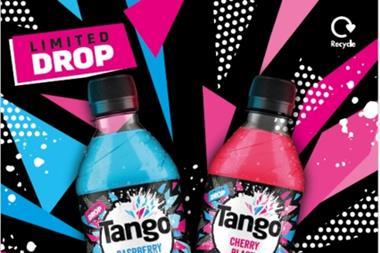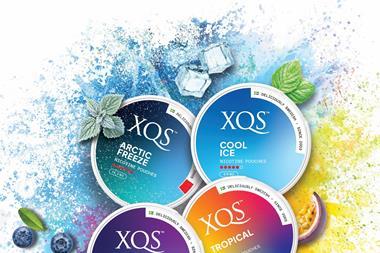From 20 May cigarette packs must contain at least 20 sticks, and feature pictorial health warnings and standardised colouring, without branding or pricemarks. Hand-rolling tobacco must also be in generic packaging, in a minimum unit size of 30g.
This May will see arguably the biggest shake-up of tobacco products in history, with the start of an entirely new regime following the imposition of EUTPD2, which governs pack sizes, and UK plain packaging legislation.
All parties involved in the trade are hoping for a smooth transition, but for retailers trying to manage the changes, the most immediate problem has been availability of popular lines before the deadline has even arrived.
Baz Jethwa, who has three stores in the Bolton, Lancashire, area, two as Costcutter and the newest one as Spar, says availability of some key lines has been “poor”.
“Customers will come to us if we have their chosen pack, but if we don’t they go elsewhere,” he says. “For example, 12.5g Amber Leaf has been hard to get hold of, and it’s our number-one best seller. You really notice a difference in sales if you have that one in stock.
“We’ve been trying to get hold of 10s if we can, but only if it’s one of the best-sellers. If there’s none on our delivery we’ve been ringing around the cash and carries.”
Jai Singh, who owns MJ’s Go Local Extra in Sheffield with wife Mandeep, agrees it has been difficult. “In Sheffield we’ve got a number of wholesalers to source from so we’ve been able to meet demand, but some lines are getting quite scarce. The 10s are disappearing, and moving from normal packs to plain packs is a challenge in itself.
“Like a lot of small stores we have been selling pricemarked packs for years, but as they expire we’ve been getting straight packs, and then had to change from normal to plain. I’d say we have about 70% of our stock in new packs now.”
Staff have had to make an adjustment, too, Jai explains. “I don’t think consumers are very well-informed about the changes, and it’s been really important to make sure staff use the right language. Initially, they were saying that we were out of stock, which makes it sound like it’s our fault, but now they explain it in terms of 10s being discontinued because of changes in the law and it is received much better.”
Arjan Mehr, a Londis retailer from Bracknell, Berkshire, believes that “the penny will drop” with smokers eventually, but in the meantime there might be some difficult conversations to be had.
“Smokers are still in ignorance about the new laws. If you don’t have 10s they tend to say they will go somewhere else; they don’t yet realise that, for some brands, there are no 10s any more.”
Tobacco manufacturers maintain that good communication is key to a successful transition. Andrew Miller, head of field sales at Imperial Tobacco UK, says: “We recommend retailers ask their preferred wholesaler for up-to-date information on SKU lines and run-out dates, and we are also informing retailers through our sales force ahead of time whenever possible when certain stocks of 10 cigarettes and lower-weight RYO packs are beginning to become unavailable.
“We have dedicated significant resource to our engagement programme, Partnering for Success, to ensure retailers are provided with extensive information and tools to support them through the transition phase. With a couple of months to go we do not anticipate a problem with non-compliant stock remaining on the market post-20 May 2017, but would urge any retailer with concerns to talk to their Imperial Tobacco rep, who will be able to assist them in managing their stock effectively.”
The relationship with your local rep is a key resource that retailers should leverage, agrees Jeremy Blackburn, head of communications at JTI, which claims to have the largest tobacco field sales force in the country.
“The cut-off point for manufacturing [old-style packs] was May last year, and plain packs have been appearing since September. Our sales force have done a great job in looking after the trade when it comes to slow-selling lines, so if you have an issue you can always ask your JTI rep, who has lots of category knowledge to draw on.
“But the key thing to focus on is stock rotation and good stock management. Old stock should be sold through in time for everyone to be compliant, but at the same time don’t just de-camp the stand, you still need to be selling tobacco and getting customers through the door right up to the May deadline and beyond. It’s still all about the basic principles of making sure you have right range available with the right brands, at the right price. And if you still have 10s in stock before the deadline when others don’t, that could present a competitive opportunity for you.”
JTI’s ‘Your Guide Through Change’ (YGTC) initiative provides practical steps to the adjustments required. The resources include videos and leaflets, hosted on the JTI Advance website or via the smartphone app. The third stage of YGTC – ‘Be Compliant’ – has just gone live. The app also says when a brand has run out and new stock is available.
Imperial’s support materials are available through its Partnering for Success START packs, which include information cards containing details of the transition to provide to adult smoker customers.
But with new packs filling up gantries across the country, merchandising is proving tricky. Baz says: “The biggest problem with the new packs is that you can’t see which product it is when it is in the gantry – you have to take it out to check what brand it is. This makes everything slower.”
To overcome this, JTI recommends that retailers simply maintain their current planograms. “The best way is to leave products where they are,” says Blackburn. “Staff know where the products are, and the status quo is the easiest thing to manage.
“I wouldn’t move the gantry to a different place either. If you move it, the risk is that the smokers won’t know you still sell tobacco.”
Baz has a vending solution in one of his stores in Bolton, which includes a mock-up gantry so that smokers know he sells tobacco. In reality, the product is stored upstairs, and packs drop down a chute to the customer once the cashier presses the right button.
“We knew that these pack changes were coming so we invested in it, and it’s been good,” says Baz. “It looks like a cig gantry from the till point, and it’s worked really well. I don’t think I’d do it again, though. The machine costs £5,000, and I think that eventually gantries will disappear altogether and people will get used to being served from drawers under the counter.”
Jai and Mandeep invested in an overhead gantry at their store in Sheffield, and Jai calls it “one of the best decisions we’ve made”.
“All the stock is visible to the staff but not to the customer, so it is compliant, and staff are always facing the customer. It’s also ours, which means we can merchandise it how we want to. And it sits in what was dead space before.”
Cigars offer opportunity
Although packs of cigars and cigarillos must feature the pictorial health warnings covering 65% of the front and back of packs, unlike cigarettes they are exempt from minimum pack sizes and plain packaging legislation.
This gives retailers an opportunity to expand sales in this category, argues Scandinavian Tobacco Ltd (STG UK), supplier of the Café Crème and Henri Wintermans brands.
Jens Christiansen, head of marketing & public affairs, says: “Cigars currently benefit from being exempt from the restrictions around minimum pack sizes and standardised packaging. As a result, cigars will still be branded beyond the product name, won’t be a standard colour, or be restricted to a minimum pack size, meaning they can still be wrapped and sold individually. In fact, due to weight, Henri Wintermans Half Corona and Sumatra will also be exempt from the health warning changes being brought in, so health warnings stay almost the same as they are currently.”
As the rollout of compliant products begins, some cigars will be by far the cheapest option on shelf and also benefit from greater visibility, so may attract existing smokers from other categories. Accounting for more than half of the entire cigar category and equipped with a portfolio of leading brands, including the number one cigar in the UK, Café Crème, STG UK says it is well positioned to help retailers take advantage of this opportunity.
“Value for money is a major trend we’ve seen impact the category in recent years and we expect this to continue and gain even further momentum when the next raft of restrictions come into effect. We can expect that price, in terms of cheapest out-of-pocket spend, is going to be a major factor for consumer purchasing decisions. As a result, segments such as small cigars/panatellas and miniatures, which account for 26% and 71% of cigar sales respectively, should be an important area of focus for retailers now and in the coming months.”
Pricing issues
Manufacturers have been eager to stress that just because packs are no longer pricemarked, it shouldn’t mean a price increase to the consumer.
Blackburn says: “Retailers are free to sell JTI products at whatever price they choose, but price is one of the key factors for existing adult smokers when choosing where to shop for tobacco, so retailers should look to remain competitive by selling at rrp or below.”
Imperial’s Miller says: “Pricing rapidly appears to be becoming the most important differentiator in the market, and on the back of this we’ve seen exceptional growth in our Player’s factory-made cigarettes to more than 12% of the sector.”
Arjan, however, is one of many retailers who have decided to edge the retail price upwards. “I think it’s okay to do this, we need to make a reasonable margin. You have to look at your immediate competitor and what they charge and take a view based on that, rather than trying to stick to a national level.”
So as all the changes begin to take effect, what will the long-term impact be? Imperial is urging retailers to look to Australia, which introduced standardised packaging in 2012. Miller says: “We’re urging retailers to learn the lessons of their Australian counterparts: and that’s not to jeopardise long-term futures in exchange for short-term gains. Recognise the importance of competitive pricing, and take this opportunity to invest in the category – as some lesser-prepared peers will drop out of selling tobacco because they see this new legislation as an added hassle.”
A recent KPMG report found that the illegal trade in tobacco increased by 20% in Australia after the imposition of plain packaging, and retailers have real fears that the same could happen over here.
Blackburn adds: “The threat of an increased illegal trade is very real, particularly with the smoker being asked to pay two to three times more for their purchase than they are used to. Controlling the supply chain will be paramount, and we are continuing to urge retailers to report any activity – it’s all about protecting your business, after all.”
In 2016 there were 247 prosecutions and 125 seizures relating to the illegal tobacco market. Since the start of 2014 JTI has removed the gantry from 27 retailers found to have been selling illegal tobacco.
Alongside worries about the illicit trade are concerns about changes to purchasing patterns. Baz says: “When we can’t get 10s any more it will affect business a lot. Shoppers buying 10s might come in every day, or even a couple of times a day. When they can only buy 20s the frequency will drop, and this will affect sales of everything else.”
JTI’s Blackburn admits “there will be a learning process that we will all go through,” but adds that “tobacco will remain vibrant after the deadline, and will remain a top product in store, no question”.
But the category’s role as a footfall-driver is in doubt, and Arjan makes a prediction: “When people are forced to make bigger purchases, this will make the sales side more erratic. It won’t be a regular, predictable purchase any more. People will probably end up buying tobacco at the nearest point to when they run out.
“Tobacco is still important, but I think there could be a role-reversal in the category. If you have a good footfall driver like food to go people will come into store because of that, and buy their tobacco on the back of it.”
changes to E-Cigs
Despite not being a tobacco product, new regulations regarding pack sizes and formulation are also coming into force for e-cigs on 20 May.
Nicotine health warnings must be included on the two largest pack sides (covering 30% of each surface); liquid bottles must be a maximum of 10ml; cartridge refills and clearomisers can hold only up to a maximum of 2ml; liquids must be produced free of specific additives and be of high grade purity; nicotine strength is capped at 20mg/ml and devices must give consistent doses. In addition, packaging is being changed to become tamper-resistant and child-proof.
Jennifer Roberts, VP customer marketing at Blu UK, welcomes the changes. “One of the key aims of the EUTPD2 legislation is to improve product quality and safety across the market, which can only be a good thing,” she says. “The legislation will mean that all vaping products will need to make changes, some more than others, so the market is expected to look quite different post-May 20. An estimated up to 84% of products currently on the market won’t be made EUTPD compliant.
“Consumers will need help finding the best alternatives, so it’s best to start talking to your customers now about the changes coming into place and ensure you’re selling them the latest version of the kits and accessories that they will still be able to buy post-May.
“If you aren’t already, you need to start to sell through any non-compliant stock in preparation for the May deadline, and don’t be tempted to bulk-buy special deals.”
All JTI’s e-cig offerings are now united under the Logic brand, with sub-brand Curv for rechargeables, Pro for capsules and LQD for tanks.
Manufacturers invest in education
Manufacturers have been trying to keep retailers fully informed about pack changes since they were announced, but have stepped up their efforts in recent weeks.
Philip Morris Ltd (PML) has developed an online educational and interactive website for UK tobacco retailers. The MyDrive Online website includes a range of content including videos to help retailers in the new era of plain packaging.
Independent retailers Ralph Patel and Dee Sedani endured a trip to Australia to see at first hand how retailers there managed the transition, which came into force in 2012, and shared their thoughts in a series of ‘Plain & Gain’ videos for the MyDrive Online site.
The videos cover how to organise the gantry, how to maintain footfall, key preparation strategies for staff and how to support the launch of new SKUs.
Ralph says: “Meeting like-minded retailers who have experienced the process first hand means PML can, through our videos, help educate the UK trade on best practice to cope with plain packaging.”
Dee adds: “I urge retailers to watch the videos to really understand the issues they will face before and after plain packaging hits their stores. It is essential that they plan now, know their products and get their prices right in order to win in the marketplace.”
Accessible to all retailers on registration, MyDrive Online features videos, brand and pricing information, ‘dos and don’t’s’ of plain packaging, interactive puzzles and a reward programme.
To support retailers and wholesalers, JTI’s ‘Your Guide Through Change’ (YGTC)initiative provides practical steps to walk the trade through the changes ahead.
The resources include free videos and information leaflets, hosted on the JTI Advance website and app so they can be accessed 24/7. JTI has just rolled out the third stage of YGTC – the ‘Be Compliant’ phase – to wholesalers and retailers in March, to help them with their preparations ahead of the May 2017 deadline.
JTI also backs the consumer-facing packchanges.co.uk website, which explains the forthcoming changes to smokers.



























No comments yet